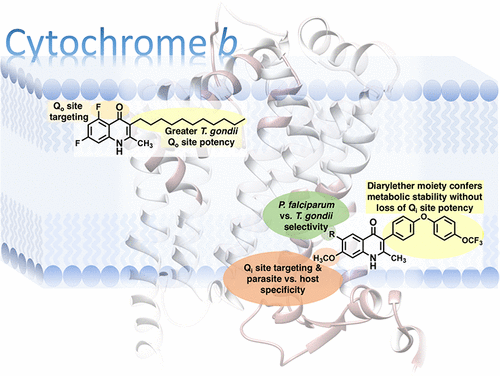当前位置:
X-MOL 学术
›
ACS Infect. Dis.
›
论文详情
Our official English website, www.x-mol.net, welcomes your
feedback! (Note: you will need to create a separate account there.)
Targeted Structure-Activity Analysis of Endochin-like Quinolones Reveals Potent Qi and Qo Site Inhibitors of Toxoplasma gondii and Plasmodium falciparum Cytochrome bc1 and Identifies ELQ-400 as a Remarkably Effective Compound against Acute Experimental Toxoplasmosis.
ACS Infectious Diseases ( IF 4.0 ) Pub Date : 2018-08-17 00:00:00 , DOI: 10.1021/acsinfecdis.8b00133 Erin V McConnell 1 , Igor Bruzual 1 , Sovitj Pou 1 , Rolf Winter 1 , Rozalia A Dodean 1 , Martin J Smilkstein 1 , Alina Krollenbrock 2 , Aaron Nilsen 1 , Lev N Zakharov 3 , Michael K Riscoe 1, 4 , J Stone Doggett 1, 5
ACS Infectious Diseases ( IF 4.0 ) Pub Date : 2018-08-17 00:00:00 , DOI: 10.1021/acsinfecdis.8b00133 Erin V McConnell 1 , Igor Bruzual 1 , Sovitj Pou 1 , Rolf Winter 1 , Rozalia A Dodean 1 , Martin J Smilkstein 1 , Alina Krollenbrock 2 , Aaron Nilsen 1 , Lev N Zakharov 3 , Michael K Riscoe 1, 4 , J Stone Doggett 1, 5
Affiliation

|
Cytochrome bc1 inhibitors have been broadly studied as human and veterinary medicines and agricultural fungicides. For the most part, cytochrome bc1 inhibitors compete with ubiquinol at the ubiquinol oxidation (Qo) site or with ubiquinone at the quinone reduction (Qi) site. 4(1H)-Quinolones with 3-position substituents may inhibit either site based on quinolone ring substituents. 4(1H)-Quinolones that inhibit the Qi site are highly effective against toxoplasmosis, malaria, and babesiosis and do not inhibit human cytochrome bc1. We tested a series of 4(1H)-Quinolones against wild-type and drug resistant strains of Toxoplasma gondii and Plasmodium falciparum. These experiments identified very potent compounds that inhibit T. gondii proliferation at picomolar concentrations. The most potent compounds target the Qo site, and for these compounds, an alkyl side chain confers potency against T. gondii greater than that of bulkier side chains. Our experiments also show that substituents on the quinolone ring influenced selectivity between T. gondii and P. falciparum and between Qo and Qi site-mediated activity. Comparison of the parasite cytochrome b sequences identified amino acids that are associated with drug resistance in P. falciparum that exist naturally in wild-type T. gondii. These underlying differences may influence drug susceptibility. Finally, a Qo site active 4(1H)-quinolone-3-diarylether tested in a murine model of toxoplasmosis was superior to atovaquone, resulting in survival from Type I strain T. gondii infection. These experiments identify highly effective compounds for toxoplasmosis and provide valuable insight into the structure–activity relationship of cytochrome bc1 inhibitors.
中文翻译:

内源性类喹诺酮类药物的靶向结构活性分析揭示了弓形虫和恶性疟原虫细胞色素bc1的强效Qi和Qo抑制剂,并将ELQ-400鉴定为对急性实验性弓形虫病非常有效的化合物。
细胞色素bc 1抑制剂已被广泛用作人类和兽药以及农业杀真菌剂。在大多数情况下,细胞色素bc 1抑制剂在泛醇氧化(Qo)部位与泛醇竞争,或在醌还原(Qi)部位与泛醌竞争。具有3位取代基的4(1 H)-喹诺酮可能会抑制基于喹诺酮环取代基的任一位点。抑制Qi位点的4(1 H)-喹诺酮类药物对弓形虫病,疟疾和杆状杆菌病非常有效,并且不抑制人细胞色素bc 1。我们针对弓形虫的野生型和耐药菌株测试了一系列4(1 H)-喹诺酮类药物和恶性疟原虫。这些实验鉴定出了在皮摩尔浓度下抑制刚地弓形虫增殖的非常有效的化合物。最有效的化合物靶向Qo位点,并且对于这些化合物,烷基侧链赋予弓形虫的效价大于体积较大的侧链的效价。我们的实验还表明,喹诺酮环上的取代基会影响弓形虫和恶性疟原虫之间以及Qo和Qi位置介导的活性之间的选择性。寄生虫细胞色素b序列的比较确定了与野生型自然存在的恶性疟原虫耐药性相关的氨基酸T.刚地 这些潜在的差异可能会影响药物敏感性。最后,在弓形虫病的小鼠模型中测试的Qo活性4(1 H)-喹诺酮-3-二芳基醚优于atovaquone,从而导致了I型刚地弓形虫感染的存活。这些实验确定了用于弓形虫病的高效化合物,并为细胞色素bc 1抑制剂的结构-活性关系提供了有价值的见解。
更新日期:2018-08-17
中文翻译:

内源性类喹诺酮类药物的靶向结构活性分析揭示了弓形虫和恶性疟原虫细胞色素bc1的强效Qi和Qo抑制剂,并将ELQ-400鉴定为对急性实验性弓形虫病非常有效的化合物。
细胞色素bc 1抑制剂已被广泛用作人类和兽药以及农业杀真菌剂。在大多数情况下,细胞色素bc 1抑制剂在泛醇氧化(Qo)部位与泛醇竞争,或在醌还原(Qi)部位与泛醌竞争。具有3位取代基的4(1 H)-喹诺酮可能会抑制基于喹诺酮环取代基的任一位点。抑制Qi位点的4(1 H)-喹诺酮类药物对弓形虫病,疟疾和杆状杆菌病非常有效,并且不抑制人细胞色素bc 1。我们针对弓形虫的野生型和耐药菌株测试了一系列4(1 H)-喹诺酮类药物和恶性疟原虫。这些实验鉴定出了在皮摩尔浓度下抑制刚地弓形虫增殖的非常有效的化合物。最有效的化合物靶向Qo位点,并且对于这些化合物,烷基侧链赋予弓形虫的效价大于体积较大的侧链的效价。我们的实验还表明,喹诺酮环上的取代基会影响弓形虫和恶性疟原虫之间以及Qo和Qi位置介导的活性之间的选择性。寄生虫细胞色素b序列的比较确定了与野生型自然存在的恶性疟原虫耐药性相关的氨基酸T.刚地 这些潜在的差异可能会影响药物敏感性。最后,在弓形虫病的小鼠模型中测试的Qo活性4(1 H)-喹诺酮-3-二芳基醚优于atovaquone,从而导致了I型刚地弓形虫感染的存活。这些实验确定了用于弓形虫病的高效化合物,并为细胞色素bc 1抑制剂的结构-活性关系提供了有价值的见解。











































 京公网安备 11010802027423号
京公网安备 11010802027423号